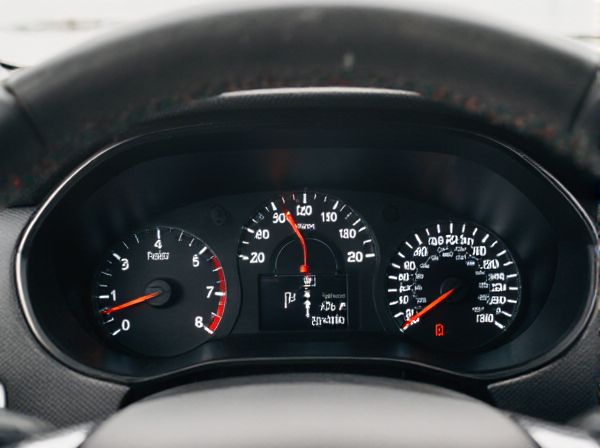
Photo illustration: Fuel Gauge vs Coolant Temperature Gauge
The fuel gauge measures the amount of fuel left in your vehicle's tank, helping you avoid running out unexpectedly. The coolant temperature gauge monitors the engine's temperature, preventing overheating by alerting you when the coolant is too hot. Understanding the difference between these gauges is essential for maintaining your vehicle's performance and preventing breakdowns.
Table of Comparison
| Feature | Fuel Gauge | Coolant Temperature Gauge |
|---|---|---|
| Function | Displays fuel level in tank | Monitors engine coolant temperature |
| Importance | Prevents running out of fuel | Prevents engine overheating |
| Location on Dashboard | Usually near speedometer | Near tachometer or temperature cluster |
| Measurement Unit | Fuel level (Empty to Full) | Temperature (degC or degF) |
| Sensor Type | Fuel level sender unit | Thermistor or temperature sensor |
| Alert Type | Fuel warning light or low fuel indicator | Temperature warning light or gauge needle rise |
| Impact on Driving | Ensures uninterrupted fuel supply | Avoids engine damage from overheating |
Introduction to Automotive Gauges
Fuel gauges measure the remaining fuel level in a vehicle's tank, providing real-time data essential for trip planning and preventing unexpected refueling stops. Coolant temperature gauges monitor the engine's operating temperature, helping to avoid overheating and ensuring optimal performance and longevity. Both gauges are critical components of automotive instrumentation, delivering vital information that enhances vehicle safety and efficiency.
Understanding Fuel Gauges: Purpose and Function
Fuel gauges measure the amount of fuel remaining in a vehicle's tank by sending electrical signals from a float mechanism inside the tank to the dashboard display, allowing drivers to monitor fuel levels accurately. This sensor relies on the varying resistance of the float arm, which moves according to fuel volume, providing real-time data to prevent running out of fuel unexpectedly. Understanding the purpose and function of fuel gauges is essential for maintaining vehicle operation and planning refueling intervals efficiently.
Coolant Temperature Gauges: Why They Matter
Coolant temperature gauges monitor the engine's operating temperature, providing critical information to prevent overheating and engine damage. By accurately displaying coolant temperature, these gauges help maintain optimal engine performance and prolong vehicle lifespan. Ignoring coolant temperature readings can lead to costly repairs caused by engine overheating or coolant system failures.
Key Differences Between Fuel and Coolant Gauges
Fuel gauges measure the amount of fuel remaining in a vehicle's tank by sending electrical signals from a float sensor to the dashboard, providing real-time fuel level data. Coolant temperature gauges monitor the engine's coolant temperature using a thermistor or temperature sensor, alerting the driver to overheating risks to prevent engine damage. Key differences include their function--fuel level monitoring versus engine temperature monitoring--and sensor type, with fuel gauges relying on float mechanisms and coolant gauges using temperature-sensitive resistors.
How Fuel Gauges Operate
Fuel gauges operate by measuring the fuel level in a vehicle's tank using a float connected to a variable resistor, which alters the electrical resistance based on the fuel amount. This change in resistance sends a signal to the dashboard gauge, providing real-time readings for the driver. In contrast, coolant temperature gauges monitor engine temperature through a thermistor sensor that varies resistance with heat, reflecting the coolant's temperature.
How Coolant Temperature Gauges Work
Coolant temperature gauges measure the engine's heat by using a thermistor sensor embedded in the engine block or cylinder head, which changes resistance according to the coolant temperature. This resistance variation alters the electrical current sent to the gauge, providing a visual indication of the engine's operating temperature. Monitoring coolant temperature helps prevent engine overheating and ensures optimal combustion efficiency for vehicle performance.
Common Problems with Fuel Gauges
Fuel gauges often suffer from inaccurate readings due to faulty sending units or wiring issues, leading to unexpected fuel depletion and potential vehicle breakdowns. Corroded or damaged fuel level sensors inside the fuel tank can cause erratic gauge behavior, making it difficult for drivers to gauge fuel levels accurately. Unlike coolant temperature gauges that primarily face sensor or thermostat failures, fuel gauge problems are frequently related to electrical faults and sensor malfunctions.
Typical Issues with Coolant Temperature Gauges
Coolant temperature gauges commonly suffer from inaccurate readings caused by faulty temperature sensors or wiring issues, which can lead to engine overheating if not addressed promptly. Corrosion or sediment buildup in the coolant system may cause the gauge to malfunction or display erratic temperatures. Regular maintenance and timely replacement of the temperature sensor help ensure reliable performance of the coolant temperature gauge, preventing potential engine damage.
Importance of Monitoring Both Gauges
Monitoring both the fuel gauge and coolant temperature gauge is crucial for optimal vehicle performance and safety. The fuel gauge provides real-time data on fuel levels, preventing unexpected breakdowns due to empty tanks, while the coolant temperature gauge alerts drivers to engine overheating, which can cause severe damage if left unchecked. Regularly tracking these gauges ensures efficient fuel management and protects the engine from thermal stress, extending vehicle lifespan and reducing maintenance costs.
Conclusion: Fuel vs Coolant Gauge – Which Is More Crucial?
The fuel gauge is more crucial for preventing unexpected engine shutdowns by ensuring the vehicle maintains adequate fuel levels for continuous operation. The coolant temperature gauge plays a vital role in monitoring engine heat to avoid overheating and potential engine damage. Prioritizing the fuel gauge helps maintain consistent vehicle function, while the coolant gauge is essential for protecting engine integrity under strenuous conditions.
 caratoz.com
caratoz.com